MBDA will equip the Royal Canadian Navy’s new Canadian Surface Combatant (CSC), a variant of the Type 26 Frigate, with Sea Ceptor missiles.
Utilising the Common Anti-air Modular Missile (CAMM) as its effector, Sea Ceptor will undertake the Close-In Air Defence System (CIADS) role on-board the new CSC frigates, say MBDA here.
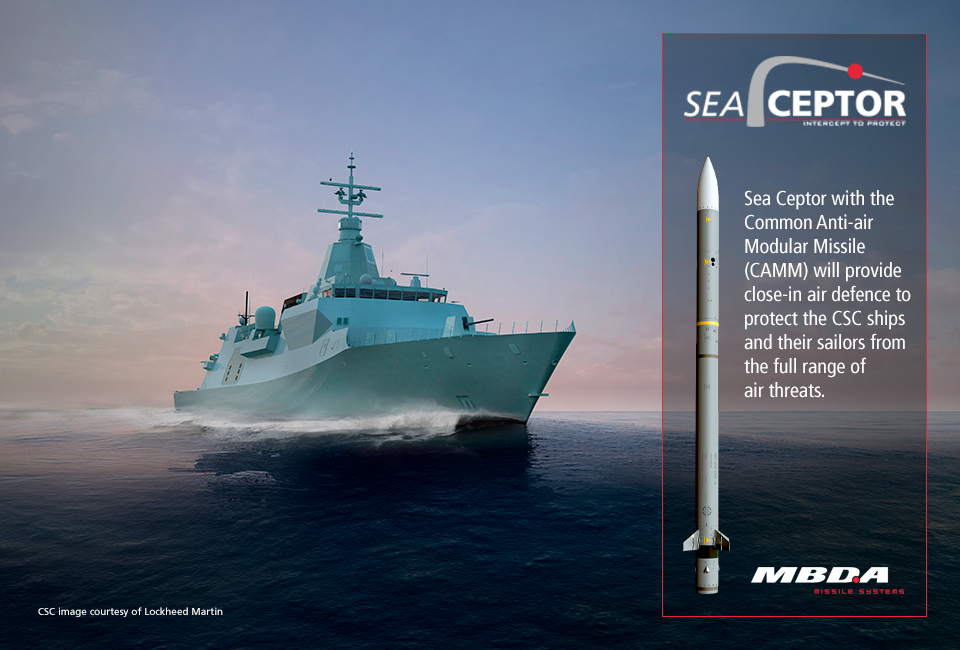
According to MBDA:
“Sea Ceptor provides exceptional self-defence performance, with a rapid response time and a high rate of fire to defeat multiple threats simultaneously. Its state-of-the-art Soft Vertical Launch (SVL) technology enables full 360° coverage with close range performance normally only associated with trainable launcher systems.
Sea Ceptor will be integrated with Lockheed Martin Canada’s Combat Management System 330 (CMS 330) as part of a multi-tier air defence capability. The CAMM missiles will be quad packed in Lockheed Martin’s Extensible Launcher System (ExLS), which is part of the Mk41 family of vertical launcher systems.”
MBDA say that its role on CSC will create a “positive impact on the Canadian defence industry and its supply chain through Canada’s Industrial and Technological Benefits (ITB) policy”.
Éric Béranger, CEO of MBDA, said in a news release:
“We are delighted to be awarded this contract, and to play a part in contributing to such an important programme to Canada. Sea Ceptor delivers next generation technology that will help protect the men and women of the Royal Canadian Navy as they carry out their missions around the world on-board the advanced new CSC frigates.”




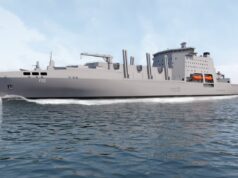

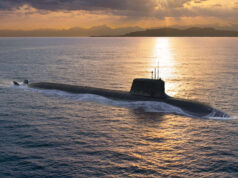

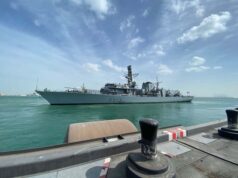
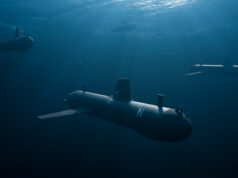
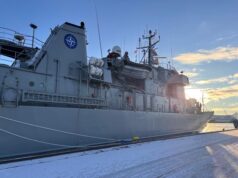



I never understood why the RN did not opt to quad pack CAAM on EXLS launchers. It would be interesting to know the cost difference.
ExLS or Sylver which the RN already uses can be quad packed. Instead the RN has chosen to use a specialist VLS system loosing much of the flexibility that a standard VLS system gives you. MBDA had a graph of SPEAR 3 quad packed in one of the standard VLS about a year ago, for example…
Short sighted stupidity on somebody’s part it seems to me.
Cheers CR
I understand Sylver quad-pack is just a paper proposal = UK need to pay for it. ExLS is a private proposal of LM, so again UK needed to pay for it if they want to use it.
Mushroom farms are of UK design and is cheap and simple. Even Italian navy selected it as “a cost effective solution”. So, there is a good reason, although I also prefer higher-density solution.
On the other hand, if you want to carry more CAMM on T26, or carry 48 CAMM in a vessel much smaller than T26, then high-density launcher starts to pay, because the hull building costs a lot.
In other words, if RN want to increase the CAMM number in future, higher density solution may replace the mushrooms. Not bad?
CAMM sales is successful as for now, and having both the cheap solution and the high-density solution are good thing. Until now, “mushrooms” are used in all T23 (Chili and UK), New Zealand’s MEKO200, and will be used in Italian PPA. ExLS is selected for Canadian T26, and possibly the Brazilian corvette (enlarged MEKO A100).
It’s also worth noting that the UK and Italy’s CAMM launcher has each cell slighly angled so that a missile that is launched whose rocket then fails will fall overboard the ship rather than on the deck. Something that ExLS does not do.
Balance between money and effectiveness. The soft launch system has two important benefits. It prevents burn issues in the missile tube, while also meaning that the ship doesn’t need to manoeuvre for a firing arc, the missile does the job. If you look at a video of soft launch you’ll see it go up, then change direction before the missile burn starts. That means the missile itself does all the work.
Because its vapourware vs an actual working system requring no investment and with which the RN is familiar, has training courses, parts and people.
Plus the RN doesnt have the missiles to fill quad packed cells. Why would you waste money having 2 ways to launch one missile?
All in all its a fuss about absolutely nothing.
It makes even less sense when the Type 26 is being fitted with Mk 41 VLS anyway. Why not just fit more of those and use some of them to quad-pack CAMM, rather than having two different sets of silos? I suppose the design was probably frozen before MBDA demonstrated the quad-pack capability, was it?
You need ExLS to be install into Mk.41 VLS to quad pack CAMM. Why not use independent ExLS and let Mk.41 filled with TLAM or alike? And, independent ExLS vs Mushroom farm is, just high-density-expensive vs low-density-cheap. Just a matter of choice.
Pretty sure the soft launch also allows a significantly reduced minimum engagement distance as the missile takes a very direct route rather than a high arching launch trajectory under a hot launch.
You don’t need ExLS in Mk.41 for quad pack, it can do it standalone (the dimensions don’t change).
Well with the UK system you get
with quad packed you get a
Joking apart if you want a one-shot-one-kill system preserving the missile in its optimum state is essential. Bit different if you are firing pairs.
Thanks fort he feedback. I guess it does make sense both from a domestic solution, cost saving and also the advantages of soft launch sealed system. I was curious why Canada whemt for the exls but maybe the additional flexibility means more to them when it comes to swapping CAAM and essm missiles etc.
Lockheed has fully qualified ceptor firing from its ExLs VLS. It is most definitely not a paper exercise.
The rest of your comment makes no sense at all.
Not quad packed it hasn’t.
There is no off the shelf wiring option to go over 48 missiles in a Mk41.
I’d stand by my other comments.
Yes, quad packed was tested. There’s film and photo’s and a press release on the internet.
Your other comments are still utterly nonsensical.
Yes quad packed was tested in the **compact** version of VLS.
There is nothing therefore that suggests that the 48 missile limit on the VLS controller cabinets being teamed up has been exceeded/planned/tested.
In fact the press release, you cite, is pretty specific that this is intended for smaller vessels where there is no space for the full thing.
I appreciate that the view that MOD/DEiS is stupid/penny pinching is an assumed view on here. But I’d say, from my own knowledge, that things are often driven more for optimal solutions: which is one tube one missile & soft launched.
If you would like to refresh you memory by reading the first post in this series, you will see we have been discussing fitting Ceptor missiles to ExLs launchers. Which is the configuration that has been qualified and features in the latest ExLs brochures along with all the control boxes in place.
You’re on your own in the weeds someplace spouting nonsense.
As usual we are talking at crossed purposed @Ron5.
If you read my comments I specifically reference the Mk41 48 missile limit. Other in the thread were confusing the Full Fat and the Skimmed (ExLs) versions of the Mk41 system.
So I am not confused and what I am saying is perfectly clear and makes sense. And accords with LM’s literature.
In the Full Fat version each row of 8 tubes needs it own controller cabinet. A maximum of 8 cabinets can be slaved together on VLS farm.
Are you seriously saying that you don’t understand that opening the top lid for a firing risks FOD and sea water getting into the quad packed tube and that this is not a good thing? If you don’t accept that then you probably don’t accept that most missile tubes are supplied with either dry air or onboard generated dry nitrogen at slightly positive pressure to keep the missile in a tip top condition free from nasty stuff like sea salt.
Just so we’re clear. “Are you seriously saying that you don’t understand that opening the top lid for a firing risks FOD and sea water getting into the quad packed tube and that this is not a good thing? If you don’t accept that then you probably don’t accept that most missile tubes are supplied with either dry air or onboard generated dry nitrogen at slightly positive pressure to keep the missile in a tip top condition free from nasty stuff like sea salt”.
The missile always comes in a hermetically sealed cannister. Whether its single (UK version Magazine Launch System MLS is it’s correct title, rather than Mushroom farm), or quad packed in a Mk25 cannister for ExLS/Mk41. The quad packs are simply the sealed munitions in an adaptor that fits into a Mk41 VLS or ExLS cell. They remain in their cannisters. When the door opens there is absolutely no way any sea water, dirt, effluent etc can get into the cannisters. Open source photos show a quad packed call with the ExLS Door opened.
Secondly, In the Full Fat version each row of 8 tubes needs it own controller cabinet. A maximum of 8 cabinets can be slaved together on VLS farm. Each launch controller has 12 missile firing cables coming from it (see the linked brochure posted by @Ron5 in the thread further down. If you were to fill a full 8 cell Mk41 VLS with quad packed CAMM, you would need 3 Launch control cabinets.
As you say yourself further down the thread 48 is a hard limit for an 8 x 8 system. And I believe that to be correct.
If you want to do something else, like launch quad packed munitions, you need a separate silo system in addition to the 8 x 8.
I do not **believe** that you can simply connect more of the ExLS controllers together for 8 tubes as the system is specific to ExLS. 3 x 3 configuration is what ExLS is specified to do. The cabinets have to control firing sequence and timings so you can’t just randomly connect them together for a row of 8.
Not “cross purposes”, you’ve been spouting nonsense from the get go.
The answer is soft launch. That system means that a simpler and cheaper less penetrative VLS can be used.for Sea Cepter. The Canucks are hedging their bets with ExLS, which could be used for conventional hot launch missiles too, but losing some of the advantages of Sea Cepter by doing so.
MBDA have shown an image of a surface to surface weapon using the Brimstone seaker and warhead on the CAMM airframe. That could also be soft launched from a warship and provide an antiship and land attack capability. Spear 3 could also be soft launched from Sea Cepter silos.
I disagree with other comments about it being a space eating option. It is the opposite.
1. Using ExLs doesn’t lose any Sea Ceptor advantages. The missile is launched and controlled in exactly the same way as if it were launched from a “mushroom” launcher. The advantage of ExLs is that more missiles are stored in a smaller volume plus human intervention is not required for the system to go from an inactive to active state. “Mushrooms” require a matelot with a wrench/spanner to remove the mushroom cap.
2. The Canadians aren’t “hedging” any bets. They are employing Sea Ceptor as a CIWS.
3. The “mushroom” Sea Ceptor launchers that will be used on the Type 31 and Type 26 frigates hold about a third less missiles for the same deck area as the ExLs.
Nonsense the mushrooms are specific to the modified SeaWolf VLS system not the Sea Ceptor VLS that Type 26 are getting. Also mushroom cap blows off at launch. The new build VLS for Sea Ceptor on Type 26 don’t have mushrooms or even if they did are not the same – and as they soft launch don’t need a whole infrastructure like Mk41 or Sylver family to vent hot gasses and keep them from entering the hull.
Hey James, T23 design was a reflection of the Seawolf VLS as you mentioned, which made a cheap design change to introduce it to T23. It also turned out that is was cheap, simple, low maintenance and very effective at supporting a missile. It therefore led into a straightforward design move to put the similar option into T26, without a complicated, expensive, extra moving parts and interfaces, higher maintenance training and support costs ExLS.
The mushroom caps are not designed to “Blow off at Launch”, quite the opposite in fact. They are peacetime protection which are removed before firing. (see any video from Youtube).
“The new build VLS for Sea Ceptor on Type 26 don’t have mushrooms or even if they did are not the same” – Again, T26 has the same environmental protection “lids” as T23.
@james you should really check your facts first before spouting your incorrect opinions.
Here’s a picture of the VLS to be fitted to the Type 31’s and Type 26. The two cells on the right have had their “mushrooms” removed manually by a sailor with a wrench.
By the way, stand alone ExLs does have hot gas venting “infrastructure”.
https://www.edrmagazine.eu/wp-content/uploads/2021/04/MBDA-Albatros-NG_09.jpg
The existing Type 23s were updated at minimum cost utilising the existing Sea wolf Silos. Type 26 and Type 31 are a different story of course. But at the end of the day it comes down to cost, and the UK always goes for the cheapest possible option. I understand they were conducting a feasibility study to establish if Type 26 and 31 could be built out of lego????
Have you seen the price of Lego, I shudder to think how much a full size Lego type 26 would cost…..steels cheaper.
Ballox. The cheapest option would be the UK not developing the ceptor missile in the first place.
This is a really great export success. The Canadians could well have gone American. If they are clever they will go with a mix Sea Ceptor and the ER variant. That doubles the engagement envelope and chances of a successful intercept, i.e. if ER doesn’t get it then the other will. I can’t understand why the RN hasn’t done the same?
That is a great idea so when you launch you can do both, and perhaps you have time to see how the ER does before you need to fire short range one if one leaker passes thru. Also definitely better to have the ExLS, I think one of the reasons RN went with mushroom farms was that was what was installed and I think ExLS came later than decision to fit on existing infra. But with T26/T31 we should be using these instead and have much more dense set up. Perhaps same for T45 if that ever gets MK41 strike length tubes?
Though perhaps not this was 2013… https://www.mbda-systems.com/press-releases/mbda-lockheed-martin-co-operation-achieves-first-missile-launch-from-a-mk-41-launcher-using-exls/ – test in the UK
Mushroom farm was borne out of necessity. Sea Ceptor simply didn’t fit fully into the old Seawolf silos.
Sea Ceptor is an easy fit into the Sea Wolf Silo’s,look at the pictures of the arrangement,it even needed adaptors as its a Smaller Diameter.
From my understanding the ER version is longer due to a longer booster, but also has a wider diameter, again because of the booster rocket. If there was a choice, the SeaCeptor loadout would be an all ER version.
The reason for this is that when you run out of the ER version you have to rely on the shorter ranged one, thus your engagement envelop is closer to the ship, so there is a greater chance of a threat getting through. As there would be less time to react to the leaker. Notwithstanding that SeaCeptor has the quickest reaction times of any ship based surface to air missile for multiple simultaneous threats, due to the cold launch method.
Furthermore, the ER version, still has the same minimum engagement range as the standard one. It just gets there a lot quicker.
Incorrect, the ER version has a longer minimum range.
The increased diameter of the ER booster has nothing to do with mixing or not mixing the two variants in the same launcher. Both the standard Ceptor missile and the ER version use the same cross section launcher container. So if the longer ER container can be accommodated, there is nothing preventing a mixed load in the same ExLs or “mushroom” array.
The minimum engagement range according to MBDA are the same, as in less than 1km.
Agree in principle, although the ER (Albatros NG) is much longer, has a larger diameter booster it can be fired from a cross sectional width cell, but is deeper. The point is as they both have the same minimum engagement ranges, then it would make more sense to only use the ER version rather than a mix.
They don’t have the same minimum range despite what you have read in the brochures, and the ER costs more, so there are two incentives for mixing and matching i.e. increased coverage and lower costs.
The RCN don’t need the ER Variant,Sea Ceptor will be used for Point Defence,they will also have ESSM and Standard for Medium/Long Range Engagements.
Exactly right, the MK41 up front will have ESSM, SM2(6), and eventually (hopefully) SM3.
RN don’t have ESSM up front so why don’t we get ER Camm? I know the T26 will operate with T45 with Viper but sometimes they will be independent.
Agree.
Got a feeling that CAMM-ER will appear in the UK’s ships at some point…
Correct. But the RN could probably make good use of the ER.
Maybe because the ER version hasn’t been available until now.
This is very interesting. The fact that the Canadians felt it necessary to have Sea Ceptor alongside ESSM speaks volumes about ESSM’s close-in engagement capabilities, i.e. non-existent? Also the fact that unlike most other operators who might have come to a similar conclusion, they’ve opted for a VL solution and not a point and shoot solution, like RAM or SeaRAM. Also, like with the RN on T26, they still feel that they want the belt and bracers approach of having Sea Ceptor and Vulcan Phalanx, so they must think that Sea Ceptor, despite its minimum range, still does not cover the entire kill envelope. Most RAM/SeaRAM operators don’t employ Phalanx as well. I must admit, their choice has surprised me but enlightened me.
I think if you are on one of these platforms under missile attack the feeling would be get as many missiles and as much lead in the air as is possible. A combined arms strategy is far better than putting all your eggs in one basket.
My above comment was slightly out – the RCN Ships won’t be equipped with Phalanx for CIWS -Sea Ceptor will provide that,ESSM will be for Point Defence and SM2 for Area Defence.
I think the issue with ESSM is that although it can be quad packed in a MK41 cell. It is still a hot launched missile. Therefore there is an enforced (necessary) time gap between a salvo launch from one cell, this may also be the case for adjoining cells. There will likely be a patterned launch sequence where non adjoining cells are fired, to prevent heat damage to a launching missile. Compared to SeaCeptor’s cold launch, which has a very small time gap between launches, mostly to prevent the missiles hitting each other when lobbed up in the air. Therefore, SeaCeptor has a much quicker reaction and firing time, which for supersonic sea skimming missiles popping over the horizon is probably more important.
This is twaddle. Please do not state your musings as fact.
Why are they musings? A cold launch system is faster to launch its missiles than a hot launch system. Purely on the basis that after a hot launch missile has fired from a cell, the next one in the cell or adjoining cell has to wait until the flame and heat from the previous missile has slightly dissipated. With a cold launch system, there is a negligible period between firings. Simples.
@DaveyB you are correct the launch sequence from Mk41 does alternate locations so as not to
It is a matter of accepted fact that it is dangerous to fire a missile into the tail of another missile, so there is a determined age launch interval from close tubes in any system I can think of, so I have no idea what planet Ron5 is on.
I am sure Ron5 will tell me I am wrong but hey ho.
Cheers.
Finally, logic wins.
His guesses agree with your guesses. Wow I’m so impressed.
In practice, there will be no difference between the rate of ESSM launches and Sea Ceptor launches due to the method of launch.
And who cares anyway, it’s the time taken and accuracy, to get to the target that matters. Jeesh.
Dear Ron5
We all bow to you amazing knowledge.
BTW how many missile test firings have you been present at: just asking?
But you know there is a tiny bit of a problem with what you are saying. I will keep this simple and use short words. And short sentences.
You have stated above that Ceptor hot launched can be used like CIWS over short range.
Now forgive me for stating as fact that you don’t fire one missile up the chuff of another missile as it is quite dangerous. I appreciate that you don’t inwardly believe this but every weapons handbook I ever saw stated a safe firing interval.
Now with cold launch you don’t have to have all time clear and vent the heat efflux and general half burned missile launch tube mess. BTW You do realise that the burn characteristics will change radically if they are launched thought hot efflux gasses: but you knew that right?
Now, old fruit, if you are going to use a missile for CIWS then the time from launch to target is pretty short if it is being used over 2-4km? Can we agree on that?
Well if we can agree on that and you fire one missile then you cannot just fire another missile until the safe interval has passed.
Which gives you a bit of a problem if you have another inbound and you are waiting for safe launch and the time to target is, well shorter, than the safe interval. Are you following this so far.
This is why a hot launch cannot be used like cold launch for CIWS use. Old fruit. And why CIWS missiles like RIM-16 uses totally separated tubes and nothing that retains heat or efflux so they can do rapid fire.
So, old fruit, you might then come to the conclusion that RN and DEiS, in their wisdom, chose the right soft launch system. Worth a thought?
Or maybe Ron5 knows more than RN & DEiS! That is truly alarming and I pray that is not the case.
Over and out.
Not sure how calling me a fruit progresses this discussion. I’m done with your nonsense.
You are guessing.
All these acronyms flying around, all armed – it could be dangerous. Keep your heads down!
This is a pretty nice confirmation of capability. I was expecting them to go with a US weapon fit out like the Australians.
They have, with the exception of CAMM instead of CIWS. It’s an Aegis Frigate in all other respects.
Just selected Italian 127mm main gun. https://www.navalnews.com/naval-news/2021/04/canada-selects-leonardo-naval-gun-systems-for-the-csc-combat-ships/
This is interesting news, and has a significant impact for the RN too; ExLScomes as a standalone 3-cell system or as a slot in pack for Mk41, which means that anything qualified for ExLS can also slot straight into a MK41 VLS without the need for it to be qualified on that system too. Which means, thanks to Canada, we can quad pack CAMM into the T26’s MK41cells!
Finally, something we have in inventory is qualified for the VLS we’ve selected for our advanced ASW frigate, even if it isn’t actually an ASW weapon.
All this, of course, only if I’ve read and understood the marketing gumpf from LM correctly…
https://www.lockheedmartin.com/content/dam/lockheed-martin/rms/documents/naval-launchers-and-munitions/VLS_Host_ExLS_Launcher_Product_Card_8.5x11_042419.pdf
Unfortunately, the ability to drop them into the silo is the easy part. For the extra missiles to be used you would have to add firing cables, missile control systems, integration into the Mk41 firing system to work alongside other missile types, etc. The 48 missile limit would need some (Very) expensive re-engineering.
Ah, really?
I thought that this was all taken care of by the fact that the ExLS system was already integrated and qualified with MK41. Therefore, CAMM just had to be integrated with ExLS and you’re away- the ExLS basically acting as a translator unit. That seems to me to be what LM’s report says. Did I mis-read it?
I know that what you describe above is basically what integration and qualification involve, but my reading of the report was that they were sidestepping that with teh ExLS qualificaiton?
@fourfiveeight is partially correct. Extra black boxes and cables would be required for slot-in, single ExLs but it’s not a crippling cost.
Take a look at the current 3 cell ExLs brochure. The pictures show the extra equipment needed for CAMM.
https://www.lockheedmartin.com/content/dam/lockheed-martin/rms/documents/naval-launchers-and-munitions/VLS_3_Cell_ExLS_Launcher_Product_Card_8.5x11_042419.pdf
That’s a handy infographic, thanks.
Yes, a few extra black boxes shouldn’t break the bank- it’s the cost and time taken for the qualification process that is normally the major roadblock in getting new weapons systems set up by my understanding. Thankfully, that’s already been done.
It may be that it never gets done for T26, but if so the question remains: What are we going to put in those Mk41?!
@ron5 – The RN already has 48 missiles attached to their system. You cannot add any more without some serious extra expenditure on changing the entire system architecture.
The 48 missile limit is a hard stop, unless you integrate a second system into the design at huge $$$$
I will be generous and admit to the OP that yes you can put them in the Mk41, but in lieu of, not additional too, the Ceptor MLS system fitted on T26. Consequently, the Mk41 cells in T26 are dedicated to the Tomahawk/FCASW future fit only as they’re already maxed out on their CAMM.
The qualification to fire from Mk41, using the quad packed ExLS adaptor has been proven. The 3 cell launcher chosen by the Canadians is a direct result of the Ceptor design architecture, as the light blue box in the picture you linked to clearly shows 12 cables coming out of it. 3 cells, quad packed, 12 missiles.
Thank The Stars – someone understands the fundamental point: it was getting exhausting!
Yup, the 48 limit is there for all kinds of reasons and is why when anyone goes above 48 deck mounted canisters or another VLS farm (Burke) or another type of launcher altogether (T26) is used.
All that said, soft launch has massive advantages so I do think RN made the best possible choice.
The only “fundamental point” you have demonstrated is your lack of knowledge on this topic and I’m not sure you understand @fourfiveeight’s last comment either.
Thanks @fourfiveeight
Would be nice if the Canadian ships had some TLAMs or equivalent land attack missiles on their ships.
They will have the MK41 vls so that will be an option.
TLAM’s are mentioned by the Canadian’s,looks like they’re getting them (not announced yet though).
Not sure why they see Sea Ceptor as a CIWS it has a stated range of 25km plus but many reports put its range at more like 60km, that is medium range and area defence.
The Canadian choice is good news for the UK and could give economy of scale for the missile, not to mention shared equipment…
It’s the effective low end range that makes it a CIWS. And minimum range of Sea Ceptor has been described as <1km.
Big thumbs up for this news! The more Ceptor users the more long term viability of the system re upgrades etc.
Indeed. The beauty and economics for the UK is the shared development and upgrade activities across other CAMM users as well as the wider ASRAAM gene pool community. For ships working alone and far from friendly air cover etc the potential option of mixing CAMM & CAMM ER must be worthy of consideration…maybe the type 32s and batch 2 Tyoe 26?.
Agree. The partnership with Italy on CAMM- ER is showing to have worked very well.
Canada orders 4 Oto 127/64 Vulcano gun for Type 26 destroyers. 3 for first ships , 1 for land training.
https://www.navalnews.com/naval-news/2021/04/canada-selects-leonardo-naval-gun-systems-for-the-csc-combat-ships/
PS: image need to be updated 😉